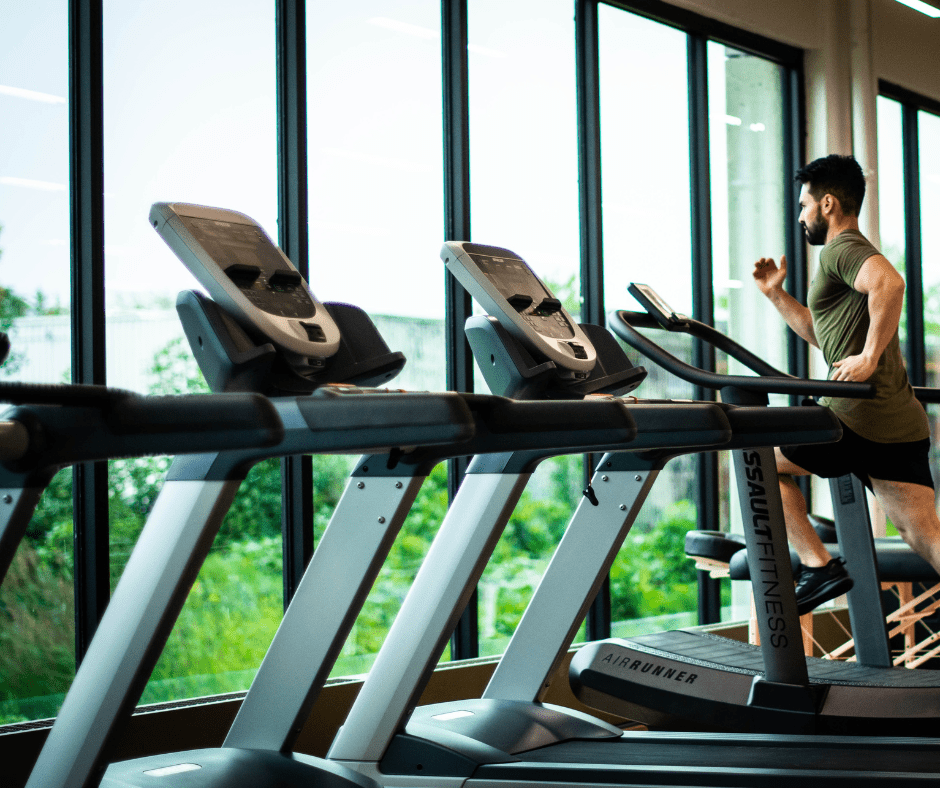Most runners prefer outdoor running as a training option for the London Marathon but, this is not always a practical option…
Training for the London Marathon on a treadmill is possible and can be a safer method for two main reasons:
1) If your training falls into the winter months then those dark winter nights can make outdoor training challenging and dangerous.
2)Treadmill training can be a safer method if you are more injury prone as the treadmill provides an impact-absorbing running surface which can reduce joint pain and stress injuries.
In this article, we are going to have a look at…
The Difference Between Running On a Treadmill & Outdoors
How To Train For The London Marathon On a Treadmill
Is It Ok To Do a Long Run On a Treadmill?
Is Running On a Treadmill Effective Training For The London Marathon?
Treadmill Marathon Training Tips To Help You Prepare For the London Marathon
Let’s begin!

The Difference Between Running On a Treadmill & Outdoors
Besides the obvious differences of one being indoors and one being outdoors…
Research shows that running on the treadmill is roughly the same as running outside if you make a few small adjustments to your treadmill workout.
Positives Of Training On a Treadmill:
- Same Level of Energy Expended: Running at a 1% incline on the treadmill expends the same energy costs as running outdoors.
- Race Simulators: Some treadmills can actually simulate the race you are training for so that you can get used to the route as much as possible, for example, The London Marathon route.
- Injury Prevention: Running on a treadmill is easier on your joints as the belt is cushioned to absorb shock, unlike the road or trail.
- Convenience: On a treadmill, you can train anytime, day or night.
- Weather Conditions & Safety: On a treadmill, you don’t need to worry about snow, hai,l, or dangerous areas.
- Long runs & Race Pace: It’s easier on a treadmill to set your required pace and stick to it.
- Builds Mental Toughness: Time feels like it ticks by slower on a treadmill therefore it becomes a bit of a mental challenge to stay focused and motivated.
Negatives Of Training On a Treadmill:
- Hamstrings & Glutes: When training on a treadmill you are receiving a small amount of help from the belt. As a result, your hamstrings & glutes won’t get the same level of adaptation as they would if you were running outdoors.
- Less Agility Required: Running on a treadmill doesn’t create the challenge of having to practice your balance and coordination like running outdoors does.
- Mind Numbing: As a lot of people call it… The dreadmill… For some reason, no matter your playlist or choice of tv show… time ticks by a lot slower when training on a treadmill.
- Overuse Injuries: Your chances of getting an overuse injury increase on a treadmill because of the repetitive motion and lack of variety in terrain.
- Vitamin D: Being indoors decreases the opportunity to enjoy the fresh air and get some vitamin D.
- Running Alone: Training on a treadmill means you aren’t able to run with your club or buddies unless they join you in the gym.
- Running Downhill & Weather Conditions: Training on a treadmill usually means you can’t run downhill at all in your sessions, it also means you don’t get any training practice while experiencing different weather conditions which may backfire come race day.
(Note: There are some modern treadmills that allow for slight downhill running)
Ultimately, treadmill vs outdoors comes down to your preference…
With that being said, if your preference or only option is training on the treadmill then let’s have a look at how you would train for The London Marathon on a treadmill.
How To Train For The London Marathon On a Treadmill
Almost four months of training on a treadmill for the London Marathon is more than enough time to train, even if you’re a beginner with only a little running experience.
In a separate article, we share with you a fail-proof London Marathon training plan. All of the runs can be completed on a treadmill as long as you stick to the pace guidelines in the plans as well as these adjustments below.
The training plans are specific to your level of experience so that all you have to worry about come race day is crossing that finish line…
London Marathon Training: Plan & Execute The Perfect Race
Treadmill Training Adjustments For The London Marathon
Long Runs
Long runs are vital to you completing the London Marathon. The purpose of a long run is to achieve several outcomes, the most important is to develop your endurance to be able to supply energy and oxygen to working muscles over longer distances.
The long run, therefore, plays an important role in improving the running economy.
Long runs teach us to be on our feet for a long time and they physiologically prepare us for going longer distances. They also allow us to experiment with different nutrition to find out what works best and what doesn’t work for our stomachs.
Treadmill adjustment:
Stick to what your training plan says in terms of pace but put the treadmill on a 1% incline. (Remember these runs are meant to be run at a very easy pace.)
Note: Treadmills differ and pacing may vary slightly. That’s why it’s important to focus on running at an easy effort.
Interval Training & Hill Intervals

Interval training involves a series of rest and running intervals for a controlled duration.
Hill interval sessions improve runners’ strength — both muscular, and cardiovascular, and increase their speed and running economy.
Treadmill adjustment:
0% incline for most intervals and 3-5% incline for hill intervals. (Advised to start out at 3% and build to 5% as you progress and if you find 3% is getting too easy.)
Some people find it more difficult and others enjoy it, so I would pay attention to how you are feeling, and if it feels harder than usual then please slow down.
Pro Tip: Be sure to follow the warm-up instructions before jumping into the session.
Time Trials
Time trials are scheduled every four weeks in your program. You can use these as an indicator of your progress and adjust your program if necessary.
The time trials are 5km or 8km depending on your time goal and should be run in the best time possible.
Treadmill adjustment:
Select a 1% incline for time trials.
Now that we know how to adjust our training runs specifically for treadmill running, let’s dive into long run’s on a treadmill…
Is It Ok To Do a Long Run On a Treadmill?
The hardest part about London Marathon training for most runners is the long runs… add that to a treadmill and most will struggle to fight the boredom of having to complete mile after mile in the same spot…
The goal is to have our long run on the treadmill provide the same training and performance benefits as it would have if you had been able to run outside.
Therefore, it is possible to have a successful long run on the treadmill, you need to try your best to replicate what you would be doing on your outdoor long run… this is in terms of your training plan and your nutrition as well as the fact that you will still need to add walk breaks in if your program prescribes, just as you would out on the road. Also, keep your nutrition on you or close so you have easy access to it.
We know it’s possible to complete our training runs on the treadmill but are they as effective…
Is Running On a Treadmill Effective Training For The London Marathon?
Research has proven that setting the treadmill to a 1% gradient accurately reflects the energy costs and simulates outdoor running.
That 1% grade offsets the lack of wind resistance and makes your treadmill sessions the same effort as running outdoors.
It may feel like you’re not getting the same benefits as runners running outdoors but remember that training on the treadmill is keeping you out of the terrible weather, safe, building mental toughness, and still progressing towards you achieving success at the London Marathon.
What you do in the 12 weeks leading up to the London Marathon will either set you up for success or failure…
Here is a proven, science-based 12-week London Marathon training plan that shows you not only what training to do every day, but exactly what pace that training should be done at so that you avoid injury and ensure you’re not over- or under-trained for come race day.
If you’ve still got your doubts about how to train for the London Marathon on a treadmill, these tips should help…
Treadmill Marathon Training Tips To Help You Prepare For the London Marathon
- Getting through long runs can be especially tough, fight the boredom by creating motivational playlists or watching your favorite tv shows, or even by setting little challenges for yourself.
- Follow a London Marathon Training Plan, this will help you prepare for the race by advising on the correct paces you need to be running.
- Don’t step on or off while the treadmill is moving, this is a big cause of treadmill injuries and can be avoided by pausing your run if you need a water or loo break and then continuing once you are back.
- Always warm up, you can briskly walk for 5 minutes, add some dynamic stretching or slowly jog before setting the treadmill to the required pace. This video will help!
- Treat your long runs as you would if you were outside, and wear the gear you plan to wear on race day so that you get used to running in it. Eg. a hat and sunglasses. Practice the nutrition you plan to use on race day, practice your hydration strategy, and walk breaks.
- The pace of your easy runs should be easy enough to hold a conversation. If you can’t find a treadmill buddy, call a friend and talk on a hands-free headset or Bluetooth headphones.
- Don’t hold on to the handrails, they are only there to help you get off and on the treadmill.
- Pay attention to your stride, you should be running on the treadmill the same way you would run outdoors.
- Cool down after your session by walking slowly for a few minutes, if you don’t you may feel dizzy as if you’re still moving when you step off the treadmill.
- Level your machine if it’s at home. Having an unleveled treadmill is a sure way to pick up a running injury without even knowing it.



Comments are closed.